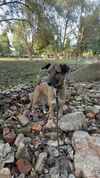Shedding Season: How To Tackle It & Keep Your Dog Happy!
{"isSaved":[],"isRead":["6523b44acbacd9e6bbb43a5a"]}

Ever tired of your dog’s hair flying around the house or stuck to your clothes all over? Shedding season can be tough – but there’s nothing to be worried about. Take comfort in the fact that it happens with all dogs and it’s natural!
Shedding is, in most situations, a natural way for your dog’s old/damaged coat to shed away. Once the older hair shed, there’s more space for healthy hair to grow. These healthy, new hair maintain your dog’s coat. The shedding process is typical for all dogs, however some shed more than others. This may be aggravating for pet parents who feel like they’re constantly vacuuming up mountains of dog fluff.
How Shedding works
The volume and frequency with which a dog sheds hair is determined by a variety of factors. Some are the dog’s breed, weather conditions, nutrition, probable allergies, and more.
Regardless of the source, shedding may be kept under control with at-home grooming and a healthy diet. Tried everything and still find yourself sifting through a sea of loose hair? Take a look at these shedding strategies.
Different ways to control dog-shedding
No parent enjoys dog hair strewn across the floor. Fortunately for us, there are a few things you can do to minimise the shedding of your dog’s coat. It may surprise you to hear that most of these dog shedding management strategies are quite low-cost.
Selecting the Correct Brush
You may need to brush your dog more frequently. Brushing will help remove stray/unattached hair. Brushes come in a variety of shapes and sizes:
- Brush with bristles: This brush is suitable for all hair types, however dogs with longer coats should use a brush with more widely spread and longer bristles. Stiffer bristles may be required for coarser hair.
- Wire-Pin Brush: This brush is best for curly, woolly coats that are medium to long in length.
- Slicker Brush: A slicker brush is made of fine wire bristles and is good for eliminating mats and tangles.
- Combs: Silicone combs massage your dog’s skin and assist short-haired canines eliminate dead hair.

Select a Tool for Shedding
Choosing a shedding tool that is made particularly to remove dead hair from your dog’s coat will help lessen the tufts you see drifting around your home, if the dog sheds seasonally or year-round. Brushes with tightly spaced stainless steel teeth that help to remove the undercoat are one type of shedding tool, while shedding blades with serrated teeth are another.
Give Your Dog a Balanced Diet
A dog that eats a comprehensive diet consisting of balanced dog food will get the vitamins and nutrients they need to maintain their hair follicles, keeping them healthy and resistant to breaking. A nutritional supplement of Omega-3 fatty acids can help certain dogs develop healthy hair while also supporting joint, heart, and immunological function. Consult your veterinarian before beginning the supplements to assess the advantages for your dog.
Increase Their Water Consumption
It’s difficult to tell how much the dog is drinking, but if they’re shedding more than normal, you should keep a check on their water dish. A dog must consume an ounce of water per pound of body weight each day as a general guideline. So, a 10-pound dog will need a little more than a cup of fresh water. Hair loss is caused by dehydrated skin, which may easily increase the quantity of stray fur that has to be cleaned up around the house.
If you want to learn more about dog shedding strategies – here’s an interesting read.
More tips ahead!
Consider shampooing and de-shedding treatments
Cleaning your dog’s fur not only helps clean their coat, but it also aids in the removal of dead hair that may become entangled with healthy hair. Moisturisers and Omega-3 fatty acids in deshedding shampoos and conditioners hydrate your dog’s skin and fur, resulting in healthier, stronger follicles while also detangling old, dead hair from new, healthy hair.
Such shampoos and conditioners can aid in removing your dog’s undercoat. Bathing your dog on a regular basis and brushing them with brushes or de-shedding products after they’re dry will help to reduce shedding dramatically.

Consult with your veterinarian
Excess shedding in dogs can be caused by medical issues too. Excessive hair loss in your dog can be caused due to parasites, fungal infections, stress, and even sunburn.
Hormonal imbalances caused by thyroid problems might result in irritated skin and fragile hair. If your dog has skin allergies, itching might be a symptom of persistent skin inflammation. The more your dog scratches themselves, the more they’re likely to shed.
Make extra time for recreation
Remember that combing and brushing your dog on a regular basis not only keeps their hair healthy, but it also allows you and your dog to bond. You may also take a stroll, play fetch, or simply hang out with your dog after grooming time. Using one or more of these shed-reduction strategies will save you both time and money in the long term, as well as prevent piles of hair from accumulating in your house. You may also conduct an overall health check on your dog while brushing and combing him: Check for any new wounds, lumps, dry skin, sores, or parasites that your veterinarian may need to treat.
It has been discovered that with these simple methods, there is less dog hair around the house, in the car, and on clothes. There will always be a few stray hair here and there, but nothing compared to a dog shedding pandemic. It will take some work on your side to decrease the quantity of dog hair in your life, but the effort will be worthwhile! Read more about hair trimming here.
